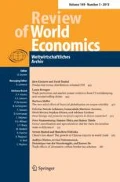Conclusion
Recent empirical research on the empirics of growth has demonstrated that an augmented Solow model provides a fairly good description of cross-country data on output per worker. Re-estimating this model by using a proxy for the stock of human capital rather than a flow measure, I find a substantially higher share of human capital in income than MRW. Given the data at hand, this result does not seem to suffer from a simultaneous equation bias, and the MRW result does not seem to suffer from measurement error. Therefore, a modified augmented Solow model is suggested that can reconcile the competing empirical estimates. For an income share of physical capital of about 1/3, the implication of this new growth model is that the impact of human capital formation on output per worker is twice as high as the positive impact of physical capital formation and the negative impact of population growth. The MRW model is less optimistic in this respect: The impact of human and physical capital accumulation is predicted to be the same, and only half as large as the negative impact of population growth.
Similar content being viewed by others
References
Barro, R. J., and J.-W. Lee (1993), International Comparisons of Educational Attainment.Journal of Monetary Economics, Vol. 32, pp. 363–394.
Lucas, R. E., Jr. (1988). On the Mechanics of Economic Development.Journal of Monetary Economics, Vol. 22, pp. 3–42.
Mankiw, N. G., D. Romer, and D. N. Weil (1992). A Contribution to the Empirics of Economic Growth.Quarterly Journal of Economics, Vol. 107, pp. 407–437.
Psacharopoulos, G. (1993). Returns to Investment in Education. A Global Update. The World Bank, Policy Research Working Papers No. 1067. Washington, D.C.
Psacharopoulos, G., and A. M. Arriagada (1992). The Educational Composition of the Labour Force: An International Update.Journal of Educational Planning and Administration, Vol. 6, pp. 141–159.
Rebelo, S. (1991). Long-Run Policy Analysis and Long-Run Growth.Journal of Political Economy, Vol. 99, pp. 500–521.
Summers, R., and A. Heston (1988). A New Set of International Comparisons of Real Product and Price Levels Estimates for 130 Countries, 1950–85.Review of Income and Wealth, Vol. 34, pp. 1–26.
— (1991). The Penn World Table (Mark 5): An Expanded Set of International Comparisons, 1950–88.Quarterly Journal of Economics, Vol. 106, pp. 327–368.
About this article
Cite this article
Gundlach, E. The role of human capital in economic growth: New results and alternative interpretations. Weltwirtschaftliches Archiv 131, 383–402 (1995). https://doi.org/10.1007/BF02707441
Issue Date:
DOI: https://doi.org/10.1007/BF02707441




